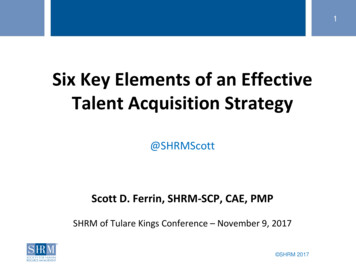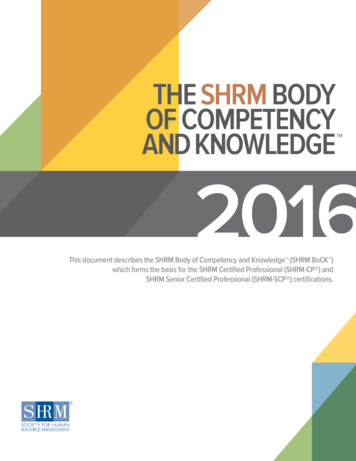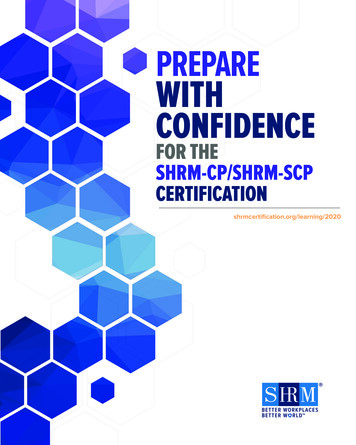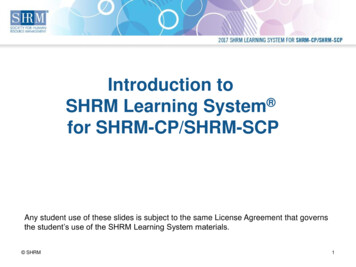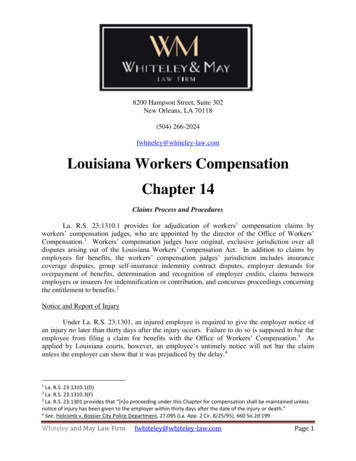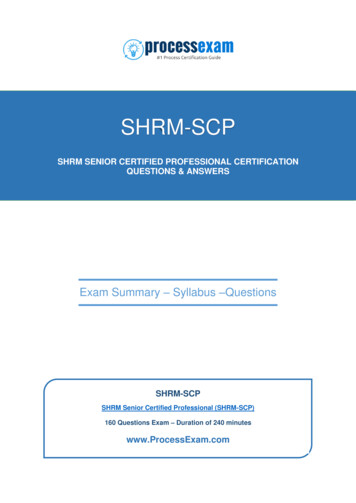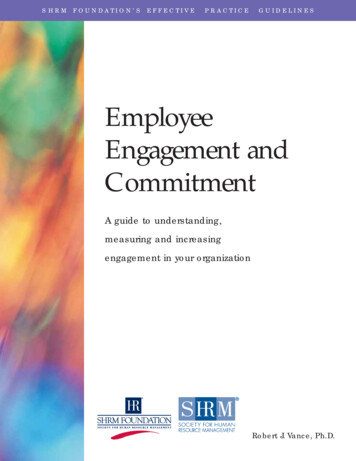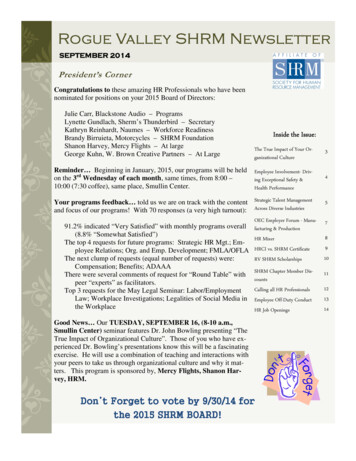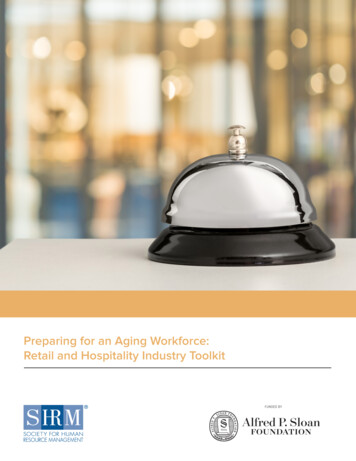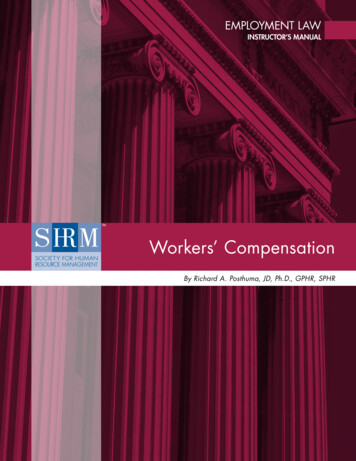
Transcription
employment lawinstructor’s ManualWorkers’ CompensationBy Richard A. Posthuma, JD, Ph.D., GPHR, SPHR
Project TeamAuthor:Richard A. Posthuma, JD, Ph.D., SPHR, GPHRSHRM project contributors:Bill Schaefer, SPHRNancy A. Woolever, SPHRExternal contributor:Sharon H. LeonardEditor:Courtney J. Cornelius, copy editorDesign:Kellyn Lombardi, graphic designer 2009 Society for Human Resource Management. Richard A. Posthuma, JD, Ph.D., SPHR, GPHRNote to HR faculty and instructors: SHRM cases and modules are intended for use in HR classrooms atuniversities. Teaching notes are included with each. While our current intent is to make the materials availablewithout charge, we reserve the right to impose charges should we deem it necessary to support the program. Pleaseduplicate only the number of copies needed, one for each student in the class.For more information, please contact:SHRM Academic Initiatives1800 Duke Street, Alexandria, VA 22314, USAPhone: (800) 283-7476 Fax: (703) 535-6432Web: www.shrm.org/education/hreducationSHRM members can download this case study and many others free of charge spx.If you are not a SHRM member and would like to become one, please visit www.shrm.org/join.09-0096-IM
ContentsIntroductionModule IEvaluating Workers’ Compensation Alternatives: A Cost-Benefit AnalysisModule IIA. Scripted Interactions Between Employer Representative and Injured WorkerB. Interactive Role Play with an Injured EmployeeC. Light Duty vs. Rehabilitation: Write a Business MemoModule IIIA. A Request for Proposal for a Workers’ Compensation Third-PartyAdministratorAppendicesA. Example: Request for Proposal (RFP) for Third-Party Administrator (TPA)ServicesB. Example: Memorandum Summarizing the Evaluation and Selection of a TPAC. Example: Court Opinion Dealing with Workers’ Compensation and FMLAD. Multiple Choice Questions and AnswersE. Example: Cost-Benefit Analysis MemorandumF. Comparison of Workers’ Compensation Costs Across the United States 2009 Society for Human Resource Management. Richard A. Posthuma, JD, Ph.D., SPHR, GPHR 1
IntroductionClassroom Activities:This module provides three in-class activities. Instructors can use all or acombination of some of the exercises.In the first class, basic workers’ compensation concepts are reviewed and analyzed.Students are given a specific case scenario in which an employer is evaluatingwhether to purchase workers’ compensation insurance, join a risk pool or selfinsure their workers’ compensation program. The facts of the case require studentsto do basic cost/benefit analysis comparing the three options. Students can workindividually or in groups to make a decision.In the second class, students analyze factual scenarios involving two differentemployee claims. Students will discuss in groups which management techniques areappropriate for the two different claims. In one claim, the facts about whether theemployee is disabled and whether the injury happened at work are clearly in dispute.In the second claim, the facts about the work-relatedness and the disability are notin dispute. However, the method for handling the claim through light-duty work ora more expensive vocational rehabilitation training program can be debated. In thisexercise, students are asked to write a business memo justifying their recommendedcourse of action.In the third class, students draft a request for proposal (RFP) for workers’compensation coverage and claims service to send to commercial insurancecompanies and third-party claims administrators. A sample RFP and a sampleevaluation of proposals memo are included in appendices A and B.This learning module is designed for students at the undergraduate level who havea major in human resource management or at least one class focused on employeecompensation and benefits, or for business students of any major who are at thegraduate level and wish to have a more advanced understanding of issues related tothe effective management of workers’ compensation issues. For those interested inlearning more about this topic, the following references may be helpful:2 2009 Society for Human Resource Management. Richard A. Posthuma, JD, Ph.D., SPHR, GPHR
nnnnnnnnKilgour, J. A Primer on Workers’ Compensation Laws and Programs. SHRMWhite Paper.http://www.shrm.org/hrresources/whitepapers published/Benefits%20TOC.asp#P198 6432.Burton, J. F. (2007). Workers’ Compensation Laws in the United States.Perspectives on Work.http://www.workerscompresources.com/Data and Articles/DataArticles.htm.Priz, E. J. (2005). Ultimate Guide to Workers’ Compensation Insurance: Secrets forReducing Workers’ Compensation Costs. McGraw-Hill.Lencsis, P. M. (1998). Workers’ Compensation: A Reference and Guide. GreenwoodPublishing Group.In preparation for the activities in these learning modules, it is recommended thatstudents read the following articles and case:nnnnnnChapman, R. D., and Garay, J. (2002). Avoiding the “Bermuda Triangle”:Navigating the ADA, FMLA, and Workers’ Comp Void. Compensation and BenefitsReview, 34, 34/3/58.Posthuma, R. (2007). Moving conventional workers’ compensation systemstoward conflict resolution. Alternatives to the high cost of litigation, 25, 179181. Retrieved from cgi-bin/fulltext/117868890/PDFSTART.Siekierka v. United Steel Deck, 373 Ill.App.3d 214, 868 N.E.2d 374, 311 Ill. Dec.374 (Ill. App. 3d., 2007). (See Appendix C.)Sample multiple choice questions and answers appear in Appendix D. 2009 Society for Human Resource Management. Richard A. Posthuma, JD, Ph.D., SPHR, GPHR 3
Module IEvaluating Workers’ Compensation Alternatives: A Cost-Benefit AnalysisNotes to the instructorOverviewThis exercise gives students a general background on the management of the riskfinancing aspects of workers’ compensation costs in a retail organization throughcommercial insurance, risk pools or self-insurance; and how this relates to theadvantages of internal loss control for loss prevention and loss reduction.Instructions:nnnnnnFirst, students should have acquired some background knowledge ofworkers’ compensation through the PowerPoint presentation and/or throughother readings.Second, have students read the exercise in Module I.Third, explain that they will be writing a memo that will be evaluated using thegrading rubric attached.An example of a cost-benefit memo appears in Appendix E.4 2009 Society for Human Resource Management. Richard A. Posthuma, JD, Ph.D., SPHR, GPHR
The AssignmentConduct a Cost-Benefit Analysis for ABC StoresABC Stores, Inc., is a retailer with 5,000 employees with stores and warehouseslocated in three different cities in the same state. Their total payroll is 200million. In recent years, the president of ABC, Chris Smith, has noticed significantincreases in the cost of their workers’ compensation (WC) benefits. He isconcerned that their current WC insurance premium of about 5 million peryear is too high. He has heard several rumors that employees may be faking theirinjuries just to get WC benefits or that they may be staying off work longer thannecessary, driving up ABC’s costs. In fact, the WC claims paid by their insurancecompany are running a little over the average for their industry for the past fewyears. ABC has one safety specialist who does loss prevention at all ABC facilities.Chris thinks that ABC’s safety program could be improved to reduce the frequencyof injuries. Chris directs you, Pat Brown, HR director, to evaluate alternatives tohelp ABC manage this situation.You and Chris have briefly discussed several options. ABC could purchase WCinsurance coverage from a commercial insurance company as they have done inthe past, or they could join a risk pool comprised of other retailers. Finally, theycould adopt a self-insurance plan. Your job is to help ABC decide which option isthe best choice. To help make this decision, you must do a cost-benefit analysis. Acost-benefit analysis helps an employer identify and evaluate the costs and benefitsof alternative courses of action. They can then decide which alternative offers thegreatest net benefits.Follow these steps in your analysis:1. Identify the expected quantifiable and non-quantifiable costs associated witheach option.2. Identify the expected quantifiable and non-quantifiable benefits associated witheach option.3. Prepare a table that lists the expected costs and benefits for each ofthe three options.4. Prepare a written report to Chris Smith in which you analyze and evaluatethe advantages and disadvantages of each option. In the report, include yourrecommendation of the option you think is best for ABC.Your report should be prepared in a professional format and be free oftypographical, grammatical and spelling errors. 2009 Society for Human Resource Management. Richard A. Posthuma, JD, Ph.D., SPHR, GPHR 5
Typically this project will be completed by teams of students, although yourinstructor may assign this as an individual assignment. If the assignment is tobe completed in teams, meet with other members in your group to decide howto prepare the report. When you are finished, turn in the final product to theinstructor. Your report will be graded using the attached grading rubric.Background InformationAlmost all states require that employers provide WC benefits to their employees. Ina few states, employers may have the option not to provide these benefits; however,if they choose not to do so, they expose themselves to additional liability. So even insuch states, most employers elect to provide WC benefits.WC benefits are required only for job-related injuries or illnesses; however, they arerequired regardless of whether the employee or the employer was at fault. Employeesare not entitled to recover pain and suffering damages from their employers forwork-related injuries or illnesses.The WC benefits that must be provided are regulated by state law and typicallyinclude the following:1. All reasonable and necessary medical expenses (e.g., doctor’s bills,laboratory tests).2. Disability income benefits (i.e., wage loss) for most periods during which theworker is unable to work.3. Death benefits to the survivors of an employee who died.4. Rehabilitation benefits (e.g., physical or occupational therapy) to help the workerregain some of their lost work capacity.Methods of Providing Workers’ Compensation Benefitsto EmployeesAssume that in the state where ABC operates, ABC has three options foradministering WC benefits. Each option is described below.Commercial InsuranceUnder this option, ABC would purchase WC coverage for all of its employeesfrom an insurance company. ABC can request quotes from several insurancecompanies, either directly or through insurance agencies. ABC would then selectthe company that gives them the best coverage and service. The insurance companywill charge ABC an insurance premium for the services it provides. This premiumcovers the insurance company’s costs and provides them with an expected profit.The calculation of the premiums for WC insurance policies usually begins with anevaluation of the number of employees in different occupational risk categories.6 2009 Society for Human Resource Management. Richard A. Posthuma, JD, Ph.D., SPHR, GPHR
The basic premium is often calculated in terms of dollars per 100 of payroll thatthe employer pays to its workers in wages. The higher the payroll and the more riskythe job classification, the greater will be the cost of paying claims. Therefore, theWC insurance premium will be higher. For example, employees who work in thewarehouse or drive trucks are more likely to have WC claims than those who work inthe office or work in sales. There are expected rates per 100 of payroll for differentjob classifications that can be used to estimate the cost of WC insurance for a typicalemployer. Table 1 on page 9 provides an example of this type of calculation forABC. Appendix F includes a table that compares the average costs of WC insurancein different states. The U.S. Department of Labor’s (DOL) Office of Workers’Compensation Programs collects data that illustrates some of the differences in howstates calculate workers’ compensation benefits. Some states provide higher benefitmaximums, and that is one of the reasons that WC costs are higher in those states.To view the data, go to the DOL website at tables-pdf/table6.pdf.After each year, the WC insurance company would provide ABC with a new quotewhen requesting renewal of coverage. That quote is based on their own costsand desired profit, the actual WC claims of ABC employees and claims handlingexpenses, and the expected claims based on the number of employees in differentjob classifications.Commercial insurance carriers can lower premiums for quantity purchases or foremployers who have a history of paying fewer claims, and can even do retrospectiverating adjustments based on formulas that consider claims incurred during the policyperiod. In the past, ABC has not really explored these alternative rating plans with itsWC insurance company; they have preferred to have a fixed-rate plan so they knowexactly what to budget for.Under the commercial insurance option, the insurance company handles all the WCclaims. Claim representatives who work for the insurance company deal directlywith employees, their doctors, and other medical service providers to determine theappropriate payments. If there is a disputed claim (i.e., the injury was not workrelated or the employee was not really disabled), the insurance company hires andpays for an attorney to defend the interests of ABC. Insurance companies are usuallygood at controlling the attorney costs, but ABC has little control over legal fees orwhether claims are settled under a commercial insurance policy. The risk of the costof individual claims is assumed by the insurance company during the year.In addition, commercial insurance carriers offer some safety consulting services totheir policyholders. It is often the case, though, that these resources are strainedbecause safety experts must provide these services to many different employers indifferent locations. 2009 Society for Human Resource Management. Richard A. Posthuma, JD, Ph.D., SPHR, GPHR 7
Risk PoolsTwo types of risk pools may be available. Under either type, the claims handlingfunction is often handled by the risk pool and its claims representatives or attorneys,just like a commercial insurance company.The first type is known as an assigned risk pool. These pools are designed to provideWC coverage to employers who have high risks of WC claims and a history ofnumerous costly claims. It is often difficult for employers with a history of expensivelosses to get coverage voluntarily from a commercial insurance company. BecauseWC coverage is mandatory, they could not operate unless they get coverage fromsome source. Therefore, many states require WC insurance companies to participatein an assigned risk pool in which a group of WC insurance companies providecoverage to these high-risk employers. Commercial insurance companies charge highrates for this type of coverage.The second type of pool is essentially a group of employers who are in the sameindustry and who all choose to share the risks of WC among themselves. Somestates permit these risk pools; others may require that the risk pool be organizedas a mutual insurance company. In either case, the goal is to take advantage of thefact that all of the employers have similar concerns, thereby enabling the risk poolto function more efficiently. For example, the types of WC claims for retailers tendto focus on back-related matters (as a result of bending and lifting). In addition,the safety consulting services will focus on the particular needs of the members.In retailing, this may include safety consultation on slips and falls, robberies, etc.However, the risk pool they may join has several members that are much larger thanthey are in terms of the numbers of employees and the premiums that they pay;therefore, ABC is concerned about the level of safety consulting services they willreceive. Nevertheless, there is an expectation that the costs will be stable and lowerbecause the pool is essentially owned and/or managed by the participants, so theywill not permit it to charge excessive rates just to make a profit for the pool. Thepools typically manage the legal defense costs in a manner similar to commercialinsurance companies.Many states also offer state-funded WC plans. These funds are designed to providecoverage to employers even if commercial insurance companies refuse to sell WCinsurance to them. This option would probably be similar to the risk pool option forABC in terms of costs and benefits. Unfortunately, ABC operates in a state that doesnot have a state fund.8 2009 Society for Human Resource Management. Richard A. Posthuma, JD, Ph.D., SPHR, GPHR
Self-InsuranceUnder this option, ABC would assume most of the risk and responsibility forpaying WC claims. Since they have only 5,000 employees and they are in a low-riskindustry, they will likely hire a third-party administrator (TPA) who will pay theclaims and deal directly with the employees and the medical service providers. In thisarrangement, the TPA assumes no risk and the costs of the claims are reimburseddirectly by ABC. TPAs hire claims handlers who are well-trained in WC matters.They are familiar with the maximum fee schedules and treatment guidelines thatmany states use to control WC medical costs for things like physical therapy andoffice visits. One of the advantages of this arrangement is that the profit margins,risk premiums, taxes, assessments, advertising expenses, etc., that are incurred bycommercial insurance companies and passed onto policyholders are less of a costfactor for TPAs. For this reason, the TPAs would probably be less expensive than aconventional WC insurance policy. However, there is greater uncertainty for ABCsince they will be required to pay whatever legitimate claims are incurred. Thus,the amount they would need to budget for this expense is not fixed. Moreover,since the TPA is not sharing the risk with the employer, they may have less of anincentive to reduce claim costs. In addition, TPAs may not have the same level ofsafety consulting services that some pools or insurance companies offer. Althoughthere are some TPAs that provide safety consulting, it is unlikely that they would befocused primarily on the loss exposures most likely for retailers. Therefore, ABC willneed to take a more active role in challenging questionable claims and in helping torehabilitate workers and get them back to work when appropriate.ABC would also incur costs to expand their own in-house safety programs. However,this could have the benefit of actually reducing the frequency of accidents. Theywould probably need to hire one or more in-house safety specialists. For legalrepresentation, they could either use the legal counsel typically used by the TPA fordisputed claims or hire legal counsel. This gives them some control over the costof attorney fees and the decision to settle disputed claims. They will also need toconsider purchasing what is known as an excess WC policy. This type of policy willhave a very high deductible for WC claims (e.g., 500,000), so it will handle onlylarge claims that might occur in the event of a catastrophic injury or event. However,even with this added cost, the total expected cost of this option is probably lowerthan a commercial insurance policy.Table 1. Workers’ Compensation Insurance Basic Rates and Projected Premium CalculationEmployeesNumberRate Per 100PayrollPremiumOffice387 0.35 15,480,000 54,180Maintenance275 5.72 11,000,000 629,200Retail/Sales3,826 1.78 153,040,000 2,724,112Warehouse467 5.46 18,680,000 1,019,928Truck Drivers45 9.23 1,800,000 166,140Total5,000 200,000,000 4,593,560 2009 Society for Human Resource Management. Richard A. Posthuma, JD, Ph.D., SPHR, GPHR 9
Grading Rubric for the Cost-Benefit Analysis ReportGrading FactorMaximumPointsLevels of Earned PointsNo typographical errors.10One point deducted for each typographical error.No spelling errors.10One point deducted for each spelling error.No grammatical errors.10One point deducted for each grammatical error.Included table with severaloptions (e.g., insurance,self-insurance) that arecorrectly described.10Three or more options correctly described 10 points.Points EarnedTwo options correctly described 5 points.Did not list options 0 points.The report includes severalcost factors that are correctlydescribed.10Two points for each cost factor that is correctly described(e.g., premiums, wages of safety professional, uncertaintyof premiums).The report offers severalbenefit factors correctlydescribed.10Two points for each benefit factor that is correctly described(e.g., greater internal control, retail expertise).A specific recommendationis made.10Made a specific recommendation 10 points.Made a vague/unclear recommendation 5 points.Did not make a recommendation 0 points.Analyzed each option.10Clearly explained the relationship between costs and benefitsand the recommendation 10 points.Somewhat vague, incomplete, or unclear analysis 5 points.Did not analyze options 0 points.Evaluated the options.10Clearly used the cost and benefit factors to evaluatealternatives and make a judgment 10 points.Somewhat vague, incomplete or unclear evaluations 5 points.Did not evaluate the options 0 points.Report looks professional.10Total points for the following:Concise 2 points.Complete 2 points.Professional layout and design 2 points.Not too many fancy special features 2 points.Easily readable 2 points.Total points possible 100Total Points Earned:10 2009 Society for Human Resource Management. Richard A. Posthuma, JD, Ph.D., SPHR, GPHR
Module IIA. Scripted Interactions Between Employer Representative and Injured WorkerInitial Injury ReportLearning Objectives:Students will learn:1. What to say when employees report a workplace injury.2. The importance of completing accident reports.3. The benefits of referring employees to high-quality and objective doctors.4. How to treat employees with respect and dignity to reduce the likelihood ofa tense or escalating conflict.5. How to interact with injured workers to collect needed information anddirect them to the appropriate medical treatment.6. How to set the stage for successful rehabilitation and a timely return to work.7. To identify which employer comments may be helpful in managing injuries.Instructions:1. Pick two students to play the roles of the injured worker andthe employer representative.2. Have the students read the scripts below, out loud to the class.3. After reading Version I, discuss the comments shown in Version Ion page 13.4. Have the students read Version II, out loud to the class.5. Have participants critique the strengths or weaknesses of each of theemployer’s statements from Version II. 2009 Society for Human Resource Management. Richard A. Posthuma, JD, Ph.D., SPHR, GPHR 11
Instructor Notes:This interactive exercise engages students in a role-play situation where they canspeak and hear the words that might be used to manage an initial report of a workrelated back injury. Research on teaching techniques shows that it is importantfor adult learners to be actively involved in the learning process; this enables themto connect the content of learning experiences to their own life experiences. Thisexercise engages students by having them act out the interaction between an injuredemployee and an employer representative.In Version I, the employer does a poor job of handling the situation. Critiques ofthe employer’s statements are used to explain the learning objectives for the exercise.In Version II, the employer does a much better job. Students will analyze andevaluate the improved comments in Version II in order to gain a greater depth ofunderstanding of the learning objectives.12 2009 Society for Human Resource Management. Richard A. Posthuma, JD, Ph.D., SPHR, GPHR
Version IInjured Worker: “I was lifting a heavy box and all of a sudden I felt a pain downin my back.”Employer Representative: “How bad is it?”Injured Worker: “Well, now every time I bend over it really hurts.”Employer Representative: “Do you want to sit down for a few minutes?”Injured Worker: “No. I don’t think that will help. I think I should see a doctor.”Employer Representative: “O.K. When will you be back?”Injured Worker: “I don’t know. Don’t you have a company doctor or somethingthat I should see?”Employer Representative: “Just because your back is sore doesn’t mean you’regoing to get workers’ comp, if that’s what you’re thinking.”Injured Worker: “Well, what should I do now?”Employer Representative: “You can take some sick time and go seeyour own doctor.”Injured Worker: “O.K. Can I go now?”Employer Representative: “I guess so, but try to be back to work as soon aspossible. We really need you to cover your shift.” 2009 Society for Human Resource Management. Richard A. Posthuma, JD, Ph.D., SPHR, GPHR 13
Version I with CommentsInjured Worker: “I was lifting a heavy box and all of a sudden I felt a pain down inmy back.”Employer Representative: “How bad is it?”.Comment 1: Rather than simply asking how bad the injury is, the employerrepresentative (ER) should do more. This is an opportunity for the ER toshow concern for the injured worker (IW). In addition, the ER should askfor more information about when and where the injury happened.Injured Worker: “Well, now every time I bend over it really hurts.”Employer Representative: “Do you want to sit down for a few minutes?”.Comment 2: Resting for a few minutes might be okay, but in this situation, a doctoror other medical expert should make an evaluation of the nature, extent, and workrelatedness of the injury. Also, the IW should probably complete an accident reportform. This is the best time to get the information about the accident because it is freshin the IW’s memory, and they may be less likely to exaggerate or make up facts.Injured Worker: “No. I don’t think that will help. I think I should see a doctor.”Employer Representative: “O.K. When will you be back?”.Comment 3: The ER should direct the IW to the employer’s preferred doctor.The IW may want to see their own doctor first, and this is permitted in manystates. However, many employers use doctors who they trust will provide a fairevaluation of the extent of the disability and the work-relatedness of the injury.Letting the IW choose his or her own doctor might result in them going to adoctor that is biased toward diagnosing a work-related disability. Moreover, theemployee should be instructed to report back on the outcome of the doctor’sexamination. This will avoid giving the IW an open-ended leave from work.14 2009 Society for Human Resource Management. Richard A. Posthuma, JD, Ph.D., SPHR, GPHR
Injured Worker: “I don’t know.”Employer Representative: “Just because your back is sore doesn’t mean you’regoing to get workers’ comp, if that’s what you’re thinking.”.Comment 4: This statement by the ER is unnecessary and argumentative.Sometimes an ER may be frustrated by WC claims and may make comments thatincrease tensions and make it more difficult to settle a dispute. A cool-headed,calm and caring approach should be used to ask objective questions aboutthe worker’s possible disability and the work-relatedness of the accident.Injured Worker: “Well, what should I do now?”Employer Representative: “You can take some sick time and go see a doctor.”.Comment 5: This is an opportunity for the ER to explain their policies or proceduresfor handling injuries. The ER should investigate the accident by asking questionsabout what happened and how, get the accident report form completed, and referthe IW to the right doctor. The ER should treat IWs with respect and dignity andexplain what pay, if any, the worker will receive for time away from work. This showsthe employee that they will get the benefits they are entitled to receive. If assured ofthis, the IW may not feel the need to go to an attorney to assert their legal rights.
Ultimate Guide to Workers' Compensation Insurance: Secrets for Reducing Workers' Compensation Costs. McGraw-Hill. n Lencsis, P. M. (1998). Workers' Compensation: A Reference and Guide. Greenwood
